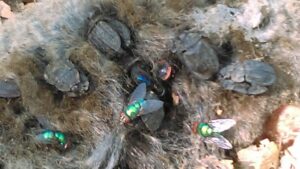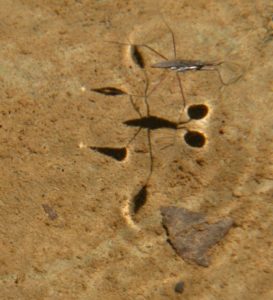By Wren Smith
Years ago, under the direction of my four year old niece Casie, I spent 45 minutes watching a fuzzy white caterpillar munching leaves. We watched in amazement as leaf after leaf disappeared beneath the appetite of this tiny herbivore. With her dedication to the task, Casie reminded me that bug watching deserves time and attention. In my years as a naturalist, I’ve witnessed numerous interactions between young children and insects. I’ve seen firsthand how an adult’s attitude can leave its mark on a child. When we show boredom, disgust, or contempt, we run the risk of snuffing out the light of delight and replacing it with fear, loathing, or dismissal. However, when we join in careful observations, the overlooked world reveals startling and sometimes beautiful dramas at our door steps. When we investigate these miniature lives we help foster what noted nature writer, Rachel Carson, referred to as The Sense of Wonder.
With the new blog series, The Bugs of Bernheim, we hope to incite your sense of wonder. Each week, check back for our newest spotlighted bug, and learn why they’re a vital part of our ecosystem.
When I was a child, I marveled at the ability of water striders to skate across the surface of the small stream near my home. I watched insect relatives, like garden spiders, wrap unlucky grasshoppers in their silken packages with lightening speed, for more casual dining later – perhaps the original sack lunch. The more I looked, the more I saw. 
Some authorities claim that there are nearly 1 million identified species of insect on earth, more than all other animals and plants combined. Almost 7,000 new insects are identified each year. Some estimate the number of species yet to be identified may be as high as 10 million species. We spend billions of dollars each year to search for life on other planets and yet the lives and lessons of these small creatures remain, in large part, undiscovered worlds.
Most people think of insects as denizens of destruction, certain to carry diseases, destroy our crops and our homes, eat our woolens, infest our pantries, and ruin our picnics. Certainly they can be “ghoulish” enough to inspire the alien parasitizing monsters in movies. However, these sorts of generalizations ignore the complexities of the web of life. Even insects that may be worrisome to us have their value in nature’s grand scheme. For example, mosquitoes and flies provide food for myriads of other creatures and some are important pollinators.
Only about 1% of insect species is harmful to humans and most are beneficial in ways that we are only beginning to fathom. Most of the fruits and vegetables that we eat are the result of the evolutionary dance between insect pollinators (especially bees) and the flowering plants.  Without the work of fly maggots, scarabs and carrion beetles and a host of other miniature undertakers, our planet would be a gigantic garbage heap in which the nutrients that enrich the planet are depleted and never replaced.
Without the work of fly maggots, scarabs and carrion beetles and a host of other miniature undertakers, our planet would be a gigantic garbage heap in which the nutrients that enrich the planet are depleted and never replaced.
We wear silk blouses thanks to the silk moth. The salmon we eat may well have sustained life by eating aquatic insects (including mosquitoes) on their long migrations. Our favorite feathered songbirds depend on insects for food.
 Summer days and nights provide us many opportunities to continue to learn from the “undiscovered” worlds of insects and their kin. If you haven’t been captivated by insects yet, hang out during an ECO Kids Saturday with Volunteer Naturalist, Corinne Mastey, as she shares her secrets of the butterflies and moths or with Joe Cichan delighting in the dragonfly nymphs and other aquatic creatures, or with our Bernheim Beekeepers.
Summer days and nights provide us many opportunities to continue to learn from the “undiscovered” worlds of insects and their kin. If you haven’t been captivated by insects yet, hang out during an ECO Kids Saturday with Volunteer Naturalist, Corinne Mastey, as she shares her secrets of the butterflies and moths or with Joe Cichan delighting in the dragonfly nymphs and other aquatic creatures, or with our Bernheim Beekeepers.
Or you could also spend time with a four year old who is enamored with insects and all the little “creepy” crawlies. They understand that amazing things often come in small packages.
Bernheim is proud to be a healthy forest, which provides a home to many creatures, even the smallest ones – insects. The Bugs of Bernheim is a blog series that will celebrate our six and eight-legged friends. Join us each year on the third Saturday in September at Bernheim’s annual BugFest, where you can see a variety of bugs, dance the buggy boogie, and even sample some tasty insect treats.



